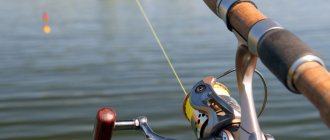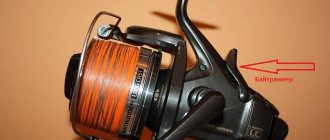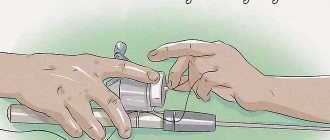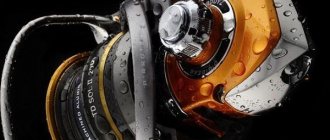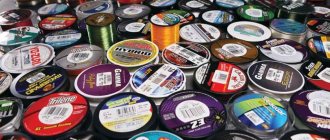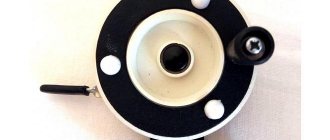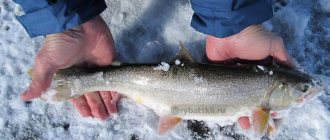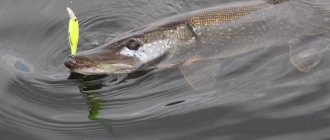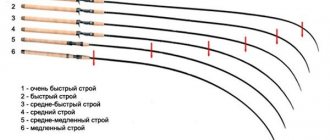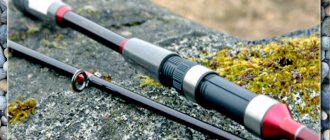In the pursuit of catching trophy specimens of predatory fish, the quality of assembly and uninterrupted operation of the equipment play an important role. One of its key elements is the coil. Here you need not just purchase a product from a trusted brand, but pay attention to the technical characteristics of the device. A well-chosen product will turn fishing into pleasure with a good catch.
This article provides recommendations for choosing a reel for beginners. All working properties of the product are disclosed in detail. The top 10 best models are given. Tips are also given for purchasing a suitable ultralight meat grinder.
How to choose according to characteristics: size, weight and other parameters
Before purchasing, you need to focus on the following technical indicators:
- product material;
- total weight;
- volume and method of laying fishing line (thread);
- size;
- gear ratio;
- smooth ride;
- the presence of a friction brake (optional).
Let's analyze each of the indicators in more detail.
Bobbin size
Manufacturers have not developed a unified size measurement system. But most brands use the thousand scale. That is, the basic size of the spool is indicated by the thousandth index.
So, they distinguish:
- 1000 – suitable for ultralight spinning rods;
- 2500 – from medium-light to medium class;
- 4000 – from medium-heavy to heavy class.
There are brands that indicate the spool size with the ending of unpaired or paired numbers. Daiwa produces a spinning reel in size 2004. If you look at it, the actual size of the spool is 2000, but it is low-capacity and is only suitable for thin braids. Therefore, when choosing, also take into account the line capacity of the spool. This way there is less chance of making a mistake when purchasing. When fishing with thin braid, a capacious spool is not needed.
IMPORTANT! The thousandth index indicates the capacity of the spool. If it says 1000, it means that you can put 100 m of fishing line with a thickness of 0.1 mm or 50 m of fishing line with a thickness of 0.2 mm into the spool. A 3000 spool size is enough for 100 m of 0.3 mm fishing line, 200 m of 0.15 mm fishing line or 300 m of 0.1 mm thick line.
Size 2500 is considered universal. It covers the maximum range of baits.
Weight for a specific rod
An equally important performance characteristic. The upper weight mark classifies the coils by power:
- ultralight (UL) – 200 g;
- light (L) – 230 g;
- medium-light (ML) – 260 g;
- medium (M) – 275 g;
- medium-heavy (MH) – 300 g;
- heavy (H) – 350 g.
Attention is often not focused on the lower mark. Many imported products are made from lightweight but durable, moisture-resistant raw materials. Due to this, their service life is several times higher than that of budget Chinese copies. It is worth remembering the balance of equipment and rod. A heavy spinning rod does not always go well with a powerful but light reel.
Availability of spare spool
It is perceived very positively by fishermen. After all, an association arises in your head that buying with a spare spool is much more profitable than without it. But it is important to look at the price. Such a kit will cost about 25-30% more.
It is important to remember that replacing the spool does not in any way affect the duration and rate of wear of the reel mechanism itself. Therefore, before purchasing, it is important to evaluate whether such a bonus is really needed in case of a significant overpayment.
The quality of laying fishing line or braided cord
This parameter cannot be assessed at the time of purchase. Therefore, when a model has been determined, it is better to go to fishing forums, ask the opinions of experienced professionals, and read reviews.
The quality of laying is important when using braiding with a jerking wiring technique. The braided cord should lie evenly on the spool without any bumps to avoid tangling or knots. There are fans of closed reels, when the spool is covered with a protective plastic cap. But here the choice is strictly individual.
Presence of friction brake
A friction brake will be needed when there is a risk of a large fish biting on a thin thread (line). When a predator makes sharp jerks, the brake releases the line to a predetermined limit, thereby protecting it from premature rupture. When making adjustments, it is important to set the limit correctly, which will work during sudden jerks.
Gear ratio
This value means the number of turns of the fishing line (thread) that the fisherman makes with 1 turn of the handle. For example, a recording of 1:5 means that in 1 turn of the handle the line will have time to wrap around the spool 5 times.
There are several types of inertia-free gear ratios:
- high-speed - from 1:6 to 1:7.2;
- universal – from 1:4.7 to 1:1.6;
- power – from 1:4 to 1:4.7.
It is recommended to take power devices for large specimens of predators. For ultralight fishing - high-speed ones. For other cases, universal coils are perfect.
Smooth running during winding
Depends on the number and location of bearings in the product. These elements answer:
- for eliminating backlashes;
- easy move;
- extending the service life of washable parts.
When purchasing a “meat grinder”, you do not need to take the product with the largest number of bearings. A device equipped with bearings on the reel axis and line roller will be more reliable.
What is coil gear ratio
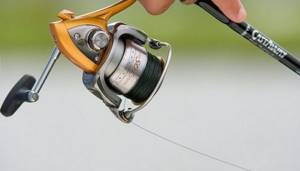
Let's first understand what a reel gear ratio is, what it is, and how this number can affect your fishing.
In modern mechanisms, torque in various components is provided by gear transmission. This is when two gears are interlocked, one of which transmits movement to the other. Thus, one of them is leading (it is turned by the engine or the fisherman through the handle), and the second is driven, since its movement is provided by the first. The rotation speed of both gears may be completely different. Thus, each gear can make its own number of revolutions in the same period of time. This is due to the different number of teeth, on which the rotation speed depends.
Let's look at a small example. If the drive gear contains 60 teeth, and the driven gear only thirty, then while the first one makes one revolution, the second one will spin as many as two times. To find out the gear ratio of such a coil, the value of the teeth of the driving gear is divided by the same number for the driven gear, that is, 60/3 = 2. Thus, the gear ratio in our example is two. So, knowing the meaning of this characteristic of the coil, what properties can we learn about in advance?
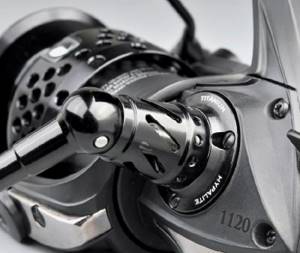
First of all, we note that the internal mechanism of the reel consists of many gears. They can be different in their properties. As soon as the fisherman begins to turn the handle, he starts the movement of the drive gear with a given number of teeth, and it already sets the rest of the mechanisms to work.
You may be interested in: How to tie a leash to the main fishing line
It is interesting to note that using the gear ratio it is possible to regulate the torque of the coil. This is achieved by changing the number of teeth in the gear.
So, the resulting rotation is transmitted by the main gear to one or more subsequent ones, which are in mesh with it. The last of these gears (or driven) rotates the line laying rotor. The manufacturer has calculated a strict number of revolutions that it will make in one full movement of the reel handle. To find out the gear ratio of the reel, it is necessary to correlate the number of rotations of the rotor with the revolutions of the handle.
Universal parameters suitable for beginners
When deciding in favor of a model, we recommend taking into account several key points:
- Size. Determined by the type of fishing. The higher the indicator, the more powerful the class. If 1000 is ultralight, then 4000 is medium-heavy to heavy.
- Spool capacity. To cover the largest range of baits, it is better to take the universal 2500.
- Weight. The main requirement is compliance with the weight of the spinning rod. Selected according to fishing characteristics.
- Gear ratio (reduction). For beginners in fishing, a ratio of 1:5 is quite enough. Minor deviations up or down are allowed.
- Friction brake. If you decide to take an inertia-free clutch with a clutch, then it is better to stop at the front one, since it responds faster to sudden jerks.
- Evenness of line winding. Here it is worth consulting in advance with experienced fishermen or familiar fishing tackle sellers.
- Availability of a spare spool. Plus - the ability to experiment with braided wire of different diameters. Minus - the cost of the coil is on average 25-30% more.
- Price range. For beginners or fishermen who go fishing infrequently, an inertia-free device at a price of 2000–4000 rubles will suffice. (provided there are no serious loads on the gear). The Stinger ForceAge XW series is an example. With intensive use, the price of a suitable product ranges from 5,000 to 15,000 rubles. A good option would be a product from Daiwa – Legalis for 2,500 rubles.
- The brand directly affects its value. Budget types include products from Select and Stinger. Expensive imported ones - Shimano, Daiwa.
Features of choice
In high-quality models of spinning reels, modern composite materials are used to make the body, making it possible to minimize the weight of the product
Spinning reels are the most versatile devices, but when choosing, you should pay attention to the following details of this product.
A high-quality spool should be made of light aluminum alloy. The spool size is chosen as large as possible if the spinning rod is used for long-distance casting of bait. The inertia-free device is equipped with stainless steel bearings. The ease of movement when reeling in the fishing line depends on the quality and quantity of these elements.
The friction brake must be smoothly adjustable; this function is especially important for fine-tuning an ultralight spinning rod. If you plan to catch fish weighing more than 3 kg, then the mechanism of the device must be equipped with a baitrunner, which allows you to release the line during strong jerks of the fish.
In high-quality models of spinning reels, modern composite materials are used to make the body, making it possible to minimize the weight of the product.
The handle should be comfortable enough to catch fish in various modes. When choosing inertia-free devices, you should study the technical data sheet of the product, which comes with the reel and packaging. Most of the parameters specified in this document can be checked when inspecting the product in a store.
Multiplier products are distinguished by a large margin of safety, have significant timber capacity and an elegant appearance. When choosing these models, the following features should be taken into account.
If the product is purchased for sea fishing, then the internal mechanisms of the device must be reliably protected from water entering the inside of the product. For trolling, you should choose models designed specifically for this type of fishing. Such devices are made of stainless steel and can be equipped with a meter.
If light baits are used for fishing, then the spinning rod is equipped with a low-profile product that will allow you to cast the bait long-distance. Such products are equipped with a magnetic brake and a function to disconnect the transmission mechanism from the drum.
Like inertia-free devices, multipliers are equipped with bearings, which ensure smooth operation. The number of bearings in high-quality devices should not be less than 3 pieces.
The gear ratio of the mechanism can be from 3.2:1 to 6.2:1. Fast models are necessary for spinning fishing for predatory fish that pursue their prey, slow ones for forcefully retrieving massive prey, and slowly retrieving the bait. The most durable and flawless in operation are multiplier devices equipped with an anti-vibration rotation system.
TOP 10 best models
According to consumer reviews, a rating of the best spinning reel models has been compiled:
- Ryobi Zauber.
- Daiwa Crest.
- Stinger Aggregate SF.
- Ryobi Excia.
- Favorite Blue Bird 17.
- Daiwa Ninja.
- Okuma Ceymar XT.
- Stinger ForceAge Neo.
- Okuma Inspira.
- Select Galaxy.
All products note the strength of the material, uninterrupted operation of the mechanism, evenness of the line winding and adaptability to different fishing conditions. You can read more about this rating by following the link.
What types of spinning reels are there?
Based on the principle of operation, they are divided into 2 types:
- inertial;
- inertialess.
Inertia-free ones are considered popular among beginners and experts. Inertial fishing rods have lost their former popularity among fishermen. But there are still those who do not change their preferences. To increase the demand for this type of mechanism, manufacturers improved it by releasing a multiplier device. Let's look at the design differences and operating features of both types.
Inertialess
Among themselves, fishermen call it “meat grinder”. Masters of sport fishing recognize it as the best spinning reel. Assembly Features:
- Manufactured with a screw drive. Transmission – conical, hypoid.
- When casting the spool does not move. This makes it possible to make long casts with light baits without any problems.
- There is a friction brake. Regulates the tension of the fishing line (cord) during sudden jerks of the predator during fishing. Prevents critical overloads.
- A spool is mounted on the main shaft of the device. All transmission mechanisms are located inside the housing.
- Inertia-free fishing does not require special skills from the fisherman. Need periodic care. Before the beginning and at the end of the fishing season, the inside is cleaned of dirt. Parts that are constantly exposed to friction are lubricated with special oils or solutions. Such procedures are easy to perform independently, without resorting to outside help.
Multiplier
Refers to modified inertia engines. The design features are as follows:
- The drum design prevents any tangling of the fishing line or thread when casting.
- Multipliers are considered power reels or, as experienced fishermen call them, “miniature winches.”
- The function of the ratchet in a multiplier is similar to the principle of operation of the clutch in a spinning gear. Regulates the gradual braking of the device when fishing.
- Although it is small in size, it has a capacious drum for winding large volumes of fishing line.
- In use it is not particularly different from the inertialess one. But to improve the quality of fishing, it is recommended to develop a clear system of movements when fishing.
- The cost of the multiplier is several times more expensive than the first type, so it has not yet gained wide popularity among fishermen.
- Purpose – for working with large jerks and deep wobblers. A suitable type of fishing is trolling.
Spinning reel
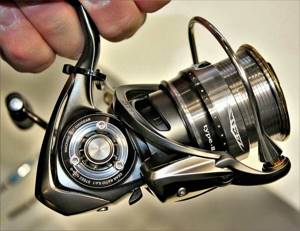
Spinning rods are considered the most popular type of fishing reel, and every spinning angler has one of these models in their arsenal. Differences from other types - in an inertia-free spool the spool does not rotate, and for winding the fishing line there is a bow rotating around the spool and a line guide.
For a spinning player who makes frequent casts, uniform winding of the warp is especially important. When the bow is raised, the line comes off the spool freely and when casting, the angler presses the base against the blank with his finger.
Inertialess reels are used not only in spinning fishing, but also with:
- feeder;
- carp rod;
- Donka;
- float rod.
The versatility of spinning baits is the main reason for their wide distribution, so it is not surprising that there is a wide range of models and price ranges, allowing the fisherman to choose the optimal solution for his conditions.
Inertia-free are divided into:
- power;
- high-speed.
The first option is used for catching heavy and large fish (carp, grass carp, catfish), the second option is suitable for spinning anglers practicing high-speed fishing.
Choosing a model for ultralight
When purchasing, you need to consider 2 main criteria:
- Small spool capacity - from 1000 to 2000. Light bait on a thin line will be easier to cast. The casting distance will increase. It’s better to take one with a front clutch. Rear drag is acceptable for heavier rods. It is not suitable for ultralight due to low sensitivity. Otherwise, you may be left without gear and catch.
- Pay attention to the quality of the coil material. It must be durable, lightweight and resistant to constant exposure to moisture.
Popular manufacturers and the role of price
The following companies made it into the top 7 best manufacturers:
- Daiwa;
- STINGER;
- Shimano;
- SALMO;
- Mikado;
- Abu Garcia;
- RYOBI.
If finances are limited, then the following are considered to be of good quality:
- Okuma;
- DAM;
- Flagman;
- Banax;
- Balzer.
In order not to purchase a cheap copy at the price of the original, you should not make such purchases in the markets. It’s much safer to go to a branded fishing store or order directly from the manufacturer’s official website. It must be remembered that imported real coils cannot cost 1000-2000 rubles. Their price range starts from an average of 8,000 rubles.
Products from Japanese and Korean companies have not left their leadership positions for years, so they strictly monitor the quality of products. Although the prices for their models are among the highest. Beginner fishermen should focus on budget devices to gain experience. Because in the event of a breakdown, due to the lack of fisherman’s skills, the amount of money spent will not be so great as to regret it.
